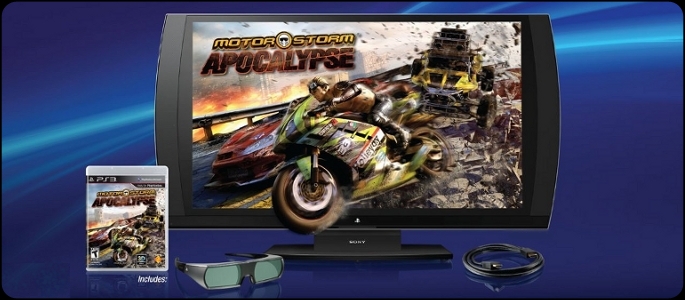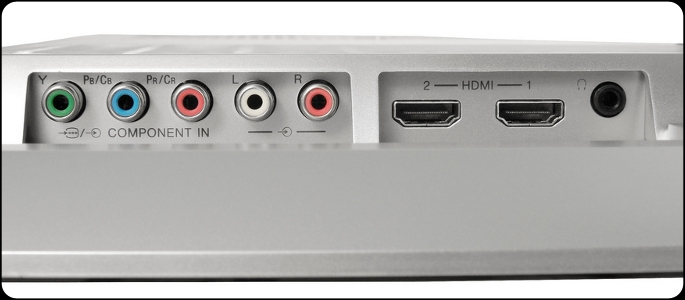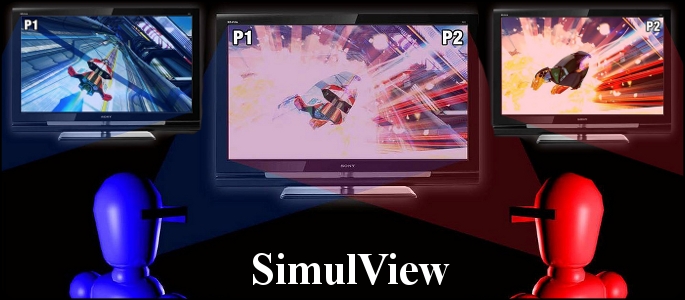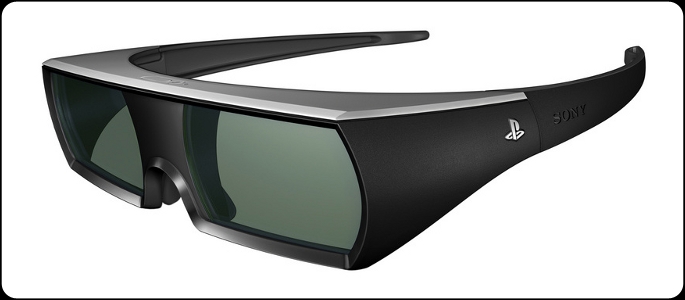In 2010, the console that “only does everything” added yet another feature to its already massive list of functionality – 3D gaming. Since then, Sony has done a fantastic job in implementing 3D into many of its games, as well as encouraging third-party partners to offer their games in 3D as well. As the 3D library has grown, so has the need for a low-cost, but high-value 3D display. Sony’s solution was revealed at E3 2011: a PlayStation 3D Display – a 24″ stereoscopic 3D display with an affordable $499 price tag.
The PlayStation 3D Display is now on sale at select retailers, just in time for the busy holiday shopping season. Has Sony created the must-have gift for gamers this holiday season?
The box includes the 24-inch 3D Display (plus power cord and stand), one pair of PlayStation-branded active-shutter 3D glasses which come in a soft pouch for safe-keeping, a micro-USB cable to charge the glasses, a 6.5 foot HDMI cable, and a copy of Motorstorm: Apocalypse – everything you need to enjoy 3D gaming on your PS3.
Set up was a breeze. Simply snap the 3D Display onto the included stand, secure with the attached screw, plug in the power cord and you’re well on your way to playing the best games the PlayStation 3 has to offer in full 1080p 3D. Your PlayStation 3 will need to be updated to firmware 3.72 or higher, and you need to sync the PS3 to work correctly with the display by holding the PS3 power button for 5-10 seconds, then follow the prompts to set up the PS3 for use with a 24-inch 3D display. The entire process is easy, and shouldn’t take more than 10 minutes from start to finish.
The display itself is well-built and reminiscent of other Sony products. It’s got a stylish rounded-edge look, with a high-gloss finish. Subtle touches, like the on/off light just above the base, elevate the display beyond your average TV’s appearance. Even the rear of the unit is adorned with a signature PlayStation logo.
Inputs and controls are on the right-hand side, just behind the TV bezel. Inputs include two HDMI ports, one component, and a headphone jack. That should be enough to cover a PS3, a cable box, and possibly another console – but I really wish there was just one more HDMI input. The headphone jack is a nice addition, mainly because the built-in speakers leave something to be desired. They’re not bad by any means, but most like TV’s, the 3D Display’s built-in speakers and integrated sub-woofer just don’t have the boom necessary to really get you into the game.
The controls are on the rear of the unit, but there isn’t a remote that goes with this display. Pressing any of the buttons will pull up a graphic overlay of the buttons on-screen. All of the buttons on-screen are representative of where the buttons are on the display itself, so there’s no wondering if your finger is on the right button. It’s a nice touch, and it’s very convenient. Not having a remote is a little strange – I get that this display is mainly designed for use in close proximity, like a desk (it can’t be wall mounted) for example, but with remote components being so cheap, the cost wouldn’t be significant to include just because.
The display uses edge-LED lighting and boasts an impressive 240hz refresh rate and full HD and 3D resolution. Picture quality is crisp, bright, and smooth. Colors are exceptionally bright, and blacks are deep and rich. Both games and Blu-ray movies look stunning on the PlayStation 3D Display. The 3D is as good as my 52″ Sony Bravia, but at 1/8th the cost of what I paid for that. The 3D still works well at wide viewing angles, and this set has exhibited very little “ghosting”, a common problem on some 3D sets. We tested a number of Blu-ray movies, both in 3D and in 2D, as well as over 20 different PlayStation 3 games, again in both 3D and 2D. Each one was as impressive as the next. Picture quality and graphics are of no concern whatsoever despite the display’s affordable price tag.
There is one feature unique to the PlayStation 3D Display that isn’t available on any other 3DTVs on the market, and that’s the patented SimulView technology. SimulView eliminates the need for splitscreen multiplayer by displaying both player’s views on the same screen, but syncing the 3D glasses in such a way that it filters out each player’s view from each other. Each player will see the action full-screen, and in full HD. Notice I said full HD – 3D isn’t possible while using SimulView – so you’re wearing 3D glasses for the SimulView effect only. I can’t say that’s a dealbreaker, but I did want to point it out. Even so, the SimulView is such a cool and useful feature.
At the moment, only three PlayStation 3-exclusive titles support SimulView and each game requires a free patch to use it. The three games are Gran Turismo 5, Killzone 3, and Motorstorm: Apocalypse. Notice that Resistance 3 is missing from the list? That’s likely why Resistance 3, which was originally announced to be the included pack-in for the 3D Display, was replaced by Motorstorm: Apocalypse. Of the three titles, Motorstorm‘s 3D is the most well-done, as is the SimulView implementation. However, it’s just as useful in all three titles. Especially Killzone 3, where the fast-paced, twitch-shooting can be hindered by playing on a split-screen. With SimulView, there’s no squinting, there’s no watching the wrong screen by ‘mistake’ (c’mon, we’ve all done that), there’s no confusion – you’re playing it as if you were alone, but so is the friend sitting next to you. And that’s only one friend; SimulView is restricted to two players.
It’ll stay that way too, because there aren’t any USB ports and the PlayStation 3D Display isn’t web-connected in any way, so there isn’t any way to upgrade the firmware on it. This also means that the display doesn’t have any built-in third-party programs like Netflix – things that other new displays are doing. But that’s fine, since the PlayStation 3D Display is most-likely being hooked up to the PS3, which has access to all of these services and more.
The glasses that come with the 3D Display are PlayStation’s low-cost 3D glasses. Most pairs of 3D glasses will run you up to about $150 a piece, but these are priced at $69.99. They’re less sturdy than the more expensive glasses, but they are by no means flimsy. The best part isn’t the value price, it’s the fact that these 3D glasses are rechargeable. On top of the inital cost of 3D glasses, most have expensive “watch” batteries that need to be changed every couple months. The PlayStation 3D glasses take nothing more than a 30-minute charge (that was the initial charge-time, it may change depending on usage) via a supplied micro-USB cable. It’s not a big deal, but it would have made more sense to go with the same mini-USB connector that the DualShock 3 uses, just to cut down on the amount of cables one has to keep around.
That, and any of the other minor complaints are completely outweighed by how feature-rich this 3D Display is for the price. SimulView is incredibly useful for anyone who plays a lot of local multiplayer, and will become even more useful as more and more games utilize the feature. It’s also really cool to show off, as no other displays or TVs are capable of it. Until that becomes more prevalent, the 3D is more than enough to make the 3D Display a must-own for PlayStation 3 owners, especially because of the price. When you look at the entire package – a 3D display, 3D glasses, HDMI cable, and a PS3 game – there’s some amazing value packed into the box.







